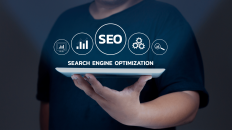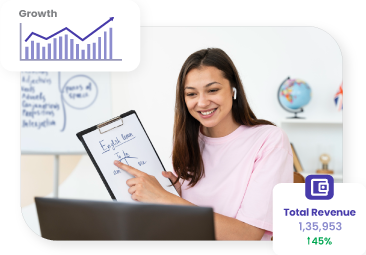Business Analytics software’s importance in the business landscape is increasing day by day. The industry is forever changing by technological advancements and evolving customer demands. Daily large data sets are being produced. To make sense of the data collected, companies are opting for analytics tools. From established companies to small startups, all are heading towards data analysis software. Analytics tools provide them with data-driven decision-making, improved efficiency, and better productivity.
In this blog post, we will discuss how business analytics software is changing business operations. We will also discuss tools like Google Analytics software. From analytics software trends to the methods maximizing the impact of analytics software. We will explore how companies streamline operations, improve decision-making, and gain insights.
Evolution of Analytics Software
- Earlier data analysis software emphasized more on reporting and business intelligence. Various programs served as ways to gather, store, and generate reports. Those programs were IBM Congos, SAS, and SAP BusinessObjects. These early tools helped businesses leverage their data to make better decisions. These programs also offered dashboarding capabilities and the ability to perform ad-hoc queries.
- Then came tools for predictive analysis. These software solutions brought advanced statistical data modeling and historical data forecasting. Analysts could study historical data. The ability to predict future outcomes and trends was in the hands of organizations.
- Analytics software evolved with the technological advancements in big data. They gained the ability to manage large and unorganized datasets. With the rise of the internet, a lot of data that is not organized has become abundant. This data includes text, images, videos, and logs. New computing frameworks were needed in the industry to process large unorganized data.
- Traditional analytics software requires servers, networking, and storage facilities. This was a costly way for many businesses. Cloud platforms bring analytics services, without any extra cost. These platforms are Google Analytics software – Google Cloud, AWS, and Microsoft Azure.
- Advancements in computational power have made complex deep-learning models more accessible with frameworks. These frameworks were PyTorch and TensorFlow, which provided more scalable and high-performance infrastructure. These frameworks were used to mature and train ML models.
- Users were required to learn query languages to operate traditional analytics software. This included complex query languages like SQL or learning visualization software. But natural interfaces made it easier for users to operate this software. They could make requests or ask questions in simple language.
Driving Force Behind The Adoption of Analytics Software in 2024
- In the past, companies used to make decisions on intuition and qualitative inputs. But as the data increased, companies began to realize the power of quantitative data. Data helps companies to remove emotional elements and bias from the process of decision-making.
- Analysts do not identify trends and patterns through senses but with statistical data. Experiments and tests can be done at a fast pace using large datasets. Data is also used to improve the efficiency of the process.
- Customer data analytics platform also collects and analyzes customer data. This is done to understand the pain points and behavior.
- Every day, the amount of data being generated is growing at an exponential rate. Companies to use this data and improve their performance need analytics software. Social media, mobile applications, IoT devices, and machine logs constantly generate data. Business analytics software provides data ingestion from various sources and formats. It provides tools to analyze text, geographical, and visual data in real time.
- The cost of analytics software has been declining over the years. The licensing and purchasing costs of these tools are becoming more affordable. Even free or less-cost analytics tools, Python, R, and Kafka. This makes small-scale companies more efficient and makes analytics infrastructure. The cost of data collection has also decreased with the rise of technologies like APIs, and IoT.
Analytics Software Trends for 2024
Analytics software trends for 2024 are given below:
AI-Augmented Analytics
AI-augmented analytics refers to analytics software that is well-equipped with AI. The quality of the software is enhanced with AI. It gifts the ability to automate, generate predictions, prepare data, and find insights. It links traditional business approaches with machine learning. Natural language processing is used to make the data functioning trouble-free for businesses.
The AI provides the ability to extract data from multiple sources and combine it for data analysis. This saves a lot of time and effort in comparison to traditional methods. AI can be asked about the data collected in a simple language. The system will search for and generate insights according to the question. The algorithm of the AI is very efficient and can find out trends, correlations, and inconsistencies in the data.
AI can generate explanations and combine information in natural language. It analyses the data to explain the trends and patterns to the users.
Predictive Analytics
Predictive analytics refers to statistical and machine learning approaches to make future predictions. Predictive analytics analyzes present and historical data to do so.
Algorithms and model parameter testing are done via analytics software. It is done to build better predictive models without having more technical experience. Predictive analytics uses predictive insights to have better business performance.
Predictive analytics tools have built-in support for databases. Database systems like Teradata, Oracle, etc. have built-in database support systems. These systems help to predict future analytics and provide better performance.
Companies are heavily investing in adopting cloud-based tools. These tools provide predictive analytics without investing in infrastructure. These tools include Microsoft Azure ML, Google Prediction API, and Amazon SageMaker.
Real-Time Analytics
Real-time analytics is the ability to analyze and process data in real-time. This allows businesses to decide and act instantly, based on the latest data. It helps businesses as the speed at which businesses operate is faster than ever. They need to act quickly so that they can stay ahead. Real-time analytics provide them with fresh data and quicker identification of changes.
Real-time analytics makes business operations more efficient. It helps analyze real-time data from equipment and sensors. This allows issues and loopholes to be identified and fixed in the present moment. This minimizes downtime and improves productivity.
Prescriptive Analytics
Prescriptive Analytics is predicted to become more important in 2024. It uses data mining, AI, and machine learning to analyze the collected data. The data is further used to suggest better suggestions, and executions to achieve business goals. It makes data analysis better by recommending specific actions.
Prescriptive analytics will use AI and ML more and decide the best actions from large data sets. This takes the burden from humans to the tool and drives better results. It optimizes their processes, outcomes, and resource consumption. This leads to improved efficiency, increased profits, and lower costs.
Prescriptive analytics will go further beyond into industries like retail, healthcare, and finance.
Best Analytics Tools in 2024
The best analytics tools for 2024 are given below:
Google Analytics
This Google Analytics software is still one of the most popular and powerful analytics software. It provides highly detailed insights into acquisition channels, website traffic, on-site behavior, etc. Integrated with Google Ads and provides custom dashboards, cohort analysis, and funnel visualization. It has built-in support for tracking websites, and Android and iOS apps. It can also be integrated with IoT devices and television platforms, providing a cross-device view.
Adobe Analytics
Adobe Analytics is a robust enterprise-level analytic tool, offered by Adobe. It offers powerful segmentation, predictive analytics, attribution modeling, and bot filtering. Being an Adobe product, it seamlessly integrates with other Adobe marketing solutions.
Amplitude
Amplitude is considered a best-in-class product, which is generally aimed at digital product teams. It allows the ability to perform deep analysis of user actions. It can be done within the website or on mobile applications. It has integration and implementation abilities via APIs, SDKs, and partnerships. It scales to collect and process up to trillions of data points every month. Big corporations like NBC, Microsoft, Instacart, Doordash, and PayPal use it.
Matomo
Matomao is a 100% open-source (GPL v3) self-hosting tool. It allows full data ownership and crosses out the concerns of third-party tracking. It provides all important website analytics functionality like top pages, e-commerce tracking, traffic sources, and conversions. It is often compared to another Google Analytics software, Google Analytics. It complies with GDPR and CCPA privacy regulations.
Looker
Looker is a business intelligence tool developed by Google. It enables users to explore and visualize data to gain insights. It incorporates LookML modeling language to combine and cleanse data from varied sources. These sources could be APIs, databases, and files. Looker offers a varied range of options for visualization, like tables, charts, maps, histograms, and charts. It can integrate natively with Google Analytics 360, Google Ads, BigQuery, and other Google tools.
Challenges while implementing Analytics Software
- Skill Gap Many corporations lack employees with analytical, statistical, and technical skills. These skills are necessary to use analytics tools and interpret data.
- Data Security and Privacy Concerns Data analysis software contains large amounts of data that is very sensitive. To prevent data leaks, maintaining data security is very important
- Choosing the Right Analytics Platform The internet is filled with a wide range of analytics software. Every tool claims to be the best for your business, but not all of them are. Choosing the right analytics software is a very crucial and tough task, but if done right, can give you better results.
- Integrating data from multiple systems Lack of data formats and identifiers can make the task of connecting data sources challenging. Bringing data together from multiple IT systems and databases can be difficult and time-consuming.
- Data Quality trouble Low-quality, incorrect, and duplicated data can lead to false analytics and insights. There could be inconsistent data formats, data gaps, duplicate records, lack of context, and metadata issues. This can be tackled by assessing data health, implementing data governance, using ETL tools, and cleaning during migration.
Best methods to maximize the impact of analytics software
- Providing proper data collection and management
Using data and cleaning techniques that would identify inconsistencies, mistakes, and values missing in the set of data. Using various data validation methods to check the accuracy of the data collected. This can be done by setting up robust data collection mechanisms and maintaining data hygiene. - Build the right models for analytics
Machine learning algorithms, predictive modeling approaches, and statistical models can help build the right models for analytics. Continuous refinement and updating models based on new data is very crucial for model building. To solve complex problems with large datasets, use advanced analytics techniques like deep learning. Make analytics output accessible - Promote data-driven culture
Encouraging a culture where data-driven decision-making is available at all aspects of the organization. Educating employees about the analytics and how to effectively leverage the data collected for business growth. - Starting with quick wins
Prioritizing potential where quick wins can be possible for tangible business impact. Focus on pain points or opportunities where analytics tools can provide immediate value. Early success can help businesses build momentum. - Checking usage and impact
Tracking and evaluating the impact of analytics software and initiatives regularly. Tracking key metrics like user engagement, and adoption rates. Use feedback tools to collect insights from users and various stakeholders to identify the areas, where improvement can be done.
Conclusion
Analytics tools have evolved over the years. As data grows, analytics tools will become more and more indispensable for companies to make decisions based on data collected. It started as a basic business intelligence tool and now has been transformed into a smart platform powered by AI and machine-learning models.
There are various trends in 2024 like AI-augmented analytics, prescriptive analytics, real-time analytics, and predictive analytics. There are also industry-leading tools like Google Analytics, Adobe Analytics, Amplitude, Matomom, and Looker.
Several challenges do arise in the adoption stage of these tools. But with the right strategy, analytics tools can provide insights and metrics that will exponentially help the business grow.





